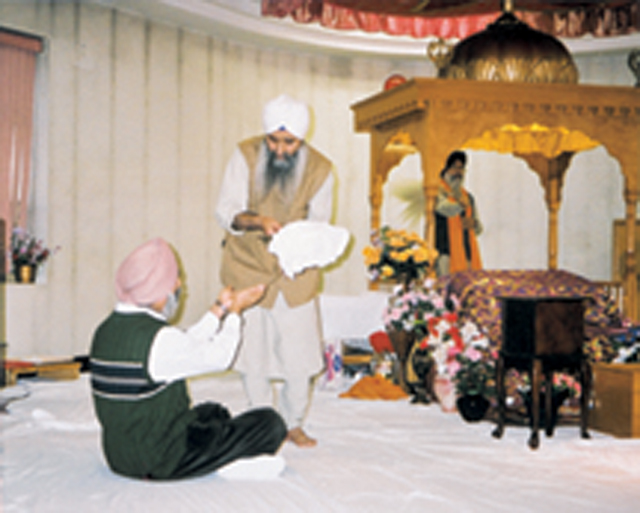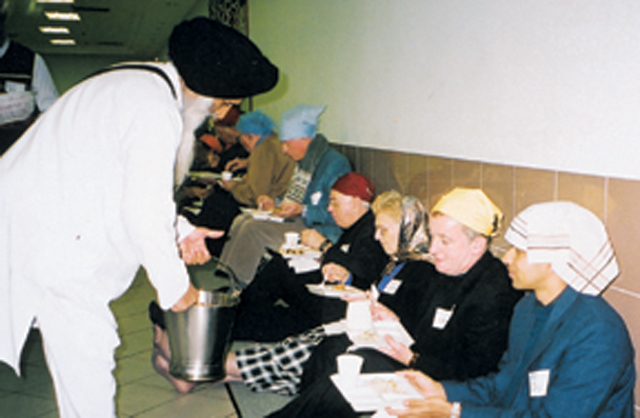FAITHS IN JOURNEY
Sharing the light of your faith in other lands
By September 2001
Return to Table of Contents
Print Article
In the last four decades, Catholics and Protestants worldwide have been rethinking their attitudes towards non-Christian religions. The Second Vatican Council of the 1960s is now seen as a watershed event in this new openness toward Jews, Muslims, Buddhists, Hindus, Aboriginals and others. Indeed, the Church has come to recognize and respect the presence of grace, truth and holiness in other religions.
 The prashaad ritual. Prashaad (meaning “grace”) is a food dispensed to the Sikh congregation as they sit with their hands cupped together to receive it. Made of sugar, flour, butter and water, the prashaad is chanted over while it is being prepared. The chant is meant to sancitify this special food. The prashaad symbolizes God’s sweetness and goodness. At the interfaith event last fall, all members of the visiting mission group were invited to partake of the sacred food.
The prashaad ritual. Prashaad (meaning “grace”) is a food dispensed to the Sikh congregation as they sit with their hands cupped together to receive it. Made of sugar, flour, butter and water, the prashaad is chanted over while it is being prepared. The chant is meant to sancitify this special food. The prashaad symbolizes God’s sweetness and goodness. At the interfaith event last fall, all members of the visiting mission group were invited to partake of the sacred food.
As well, the Church realizes that it can receive spiritual gifts in its conversation with other religious traditions. This conviction is best capsulized in the words of John Paul II: “By dialogue, we let God be present in our midst, for as we open ourselves to one another, we open ourselves to God.”
Across the planet, Catholic missionaries are embracing the challenge of interfaith dialogue; they are also struggling to interpret this challenge in light of the call to Christian mission.
In the fall of 2000, Scarboro Missions invited priests, nuns and lay personnel from a number of Toronto missionary organizations to embark upon a day of dialogue.
The first stop was a Sikh temple in Scarborough, Ontario. Following a cold bus ride, 40 mission pilgrims were ushered into the warm hospitality of the Sikh people. As the guests entered the Sikh house of worship, they were invited to remove their shoes and put on head coverings. Both of these Sikh customs are a way of showing respect for God while in the temple.
After a tour of the temple, guests had the opportunity to witness a dynamic worship service that featured prayers, singing and music played on a variety of instruments. Members of the temple then shared the history and traditions of Sikhism, an exercise that stimulated a volume of questions.
Next, it was on to what is perhaps the cornerstone of Sikh hospitality—the langar (community meal). Each day of the week, every Sikh temple provides free meals to any and all visitors, be they Sikh or non-Sikh.
I am a stranger to no one; and no one is a stranger to me. Indeed, I am a friend to all.
The Golden Rule as found in the sacred book of Sikhism, the Guru Granth Sahib (pg. 1299)
Physically and spiritually nourished, the journeying missioners made their way back to the Scarboro Mission Centre to hear a panel of speakers representing five world faiths—Buddhism, Hinduism, Sikhism, Islam and Judaism.
 Guests at the Sikh temple are treated to a community meal (langar). Each day, every Sikh temple provides a free meal to visitors. Sikh or non-Sikh. In the dining room, people sit on the floor in rows facing one another. “We sit like this because it is like the family getting together. When you eat together, you understand each other,” said Piara Singh Minhas, a member of the temple.
Guests at the Sikh temple are treated to a community meal (langar). Each day, every Sikh temple provides a free meal to visitors. Sikh or non-Sikh. In the dining room, people sit on the floor in rows facing one another. “We sit like this because it is like the family getting together. When you eat together, you understand each other,” said Piara Singh Minhas, a member of the temple.
The theme chosen for the afternoon panel was “Faiths in journey: Sharing the light of your faith in other lands.” Each panelist was asked to sketch an historical outline of his faith tradition, with a specific focus on the spread of that given religion throughout the world.
This day of global journeying culminated with the celebration of the Eucharist in honour of St. Francis Xavier. Some members of the interfaith panel attended. Throughout the Mass and in his homily, the celebrant, Fr. Jack Lynch, Superior General of Scarboro Missions, stressed the importance of dialogue and diversity.
Congratulations
Thank you for your letter and for the enclosed copy of Scarboro Missions (Special issue: Interfaith Dialogue, January-February 2000) and the Scarboro Missions Golden Rule poster depicting 13 religions...
Going through the issue of Scarboro Missions I want to make a particular mention of Paul McKenna’s article, “John Paul II, Interfaith Giant”, especially the chronology of interreligious events he presents during the Pontificate of the Pope. Congratulations to all those who worked on bringing this edition out.
Francis Cardinal Arinze
President, Pontifical Council for Interreligious Dialogue
The Vatican
Dialogue is a part of mission
The Catholic Church’s understanding of interreligious dialogue has developed significantly in recent years particularly in reference to mission. In the Vatican II documents, the Council highlights the importance of dialogue with other religions, but falls short of saying that interfaith dialogue is a part of the Church’s mission.
However, in 1984, the Vatican’s Secretariat for Non-Christians (known today as the Pontifical Council for Interreligious Dialogue) published a document called Dialogue and Mission. In this document, we see for the first time that interreligious dialogue is included as an element of mission. In fact, it is included in the five principal elements of mission: Presence, Service, Dialogue, Proclamation, and Sacramental Life of the Church.
Since 1984, two other official documents have similarly claimed that interreligious dialogue is an integral part of the Church’s mission. The first of these is Pope John Paul II’s 1990 encyclical, The Mission of the Redeemer; the second document, Dialogue and Proclamation, was produced by the Pontifical Council for Interreligious Dialogue.
Fr. Jacques Dupuis, S.J., in his book, “Toward a Christian Theology of Religious Pluralism”, says the three Vatican documents, with their different emphases and perspectives, constitute a significant advance in the Church’s teaching on mission, dialogue and the proclaiming of the Gospel.
Summary of an interfaith presentation by Fr. Ray O’Toole at the Canadian Mission Congress 2001, Cornwall, ON, May 2001. Fr. O’Toole is Assistant General on Scarboro Missions General Council and Coordinator of the Scarboro Missions Interfaith Desk.
Return to Table of Contents
Print Article